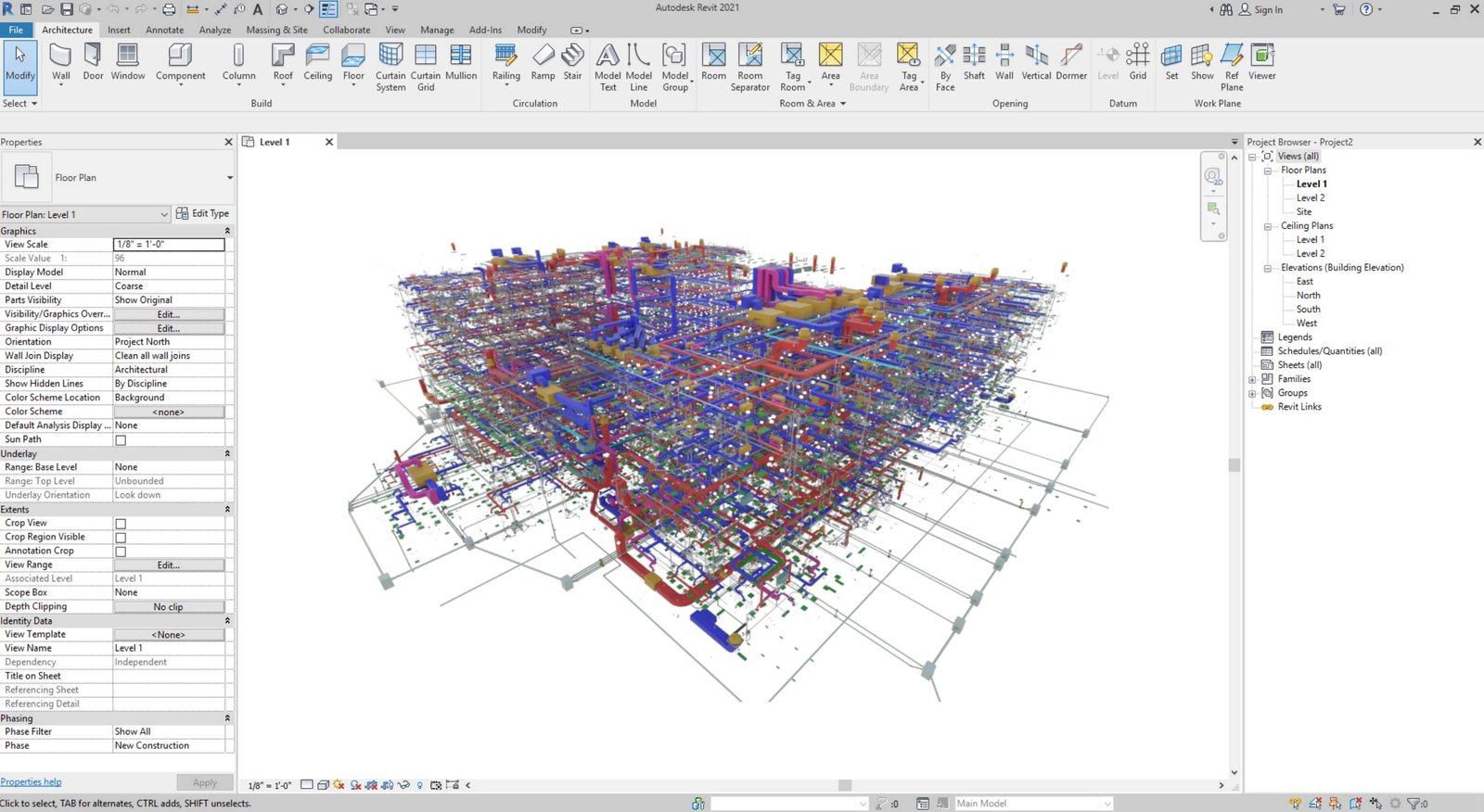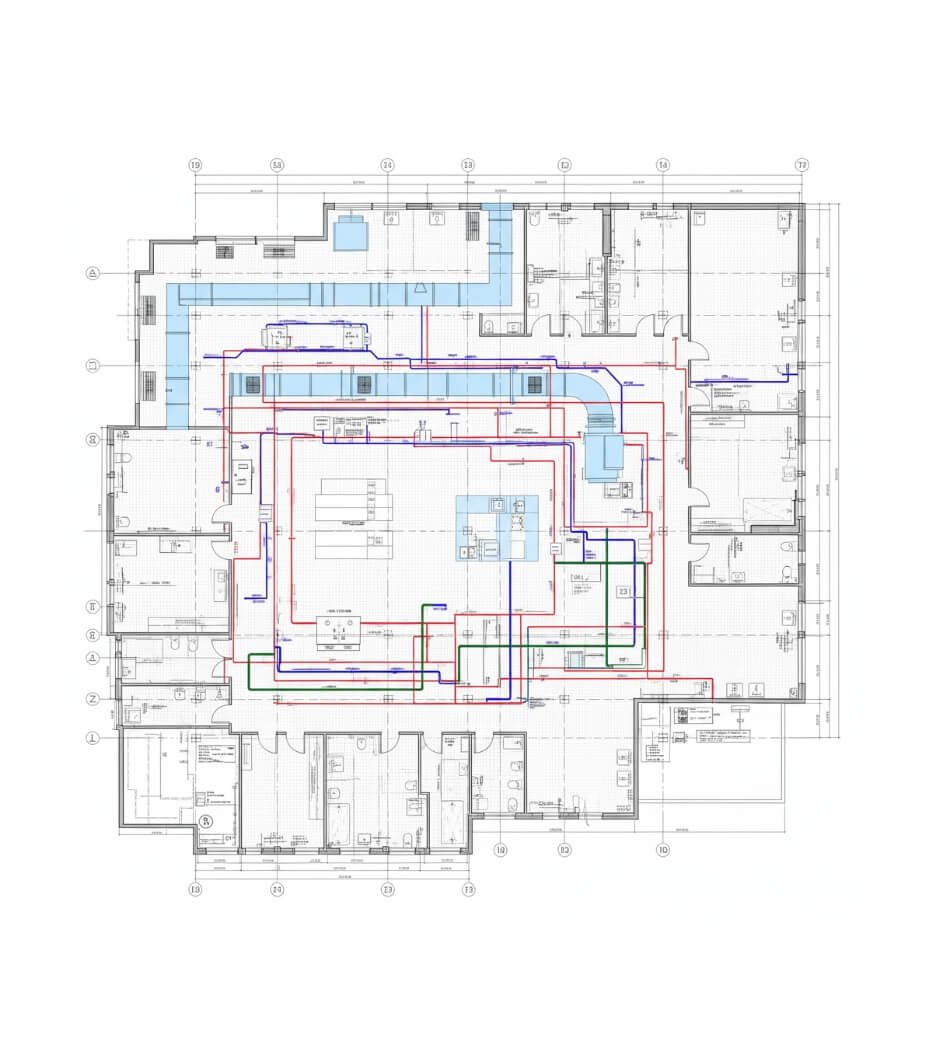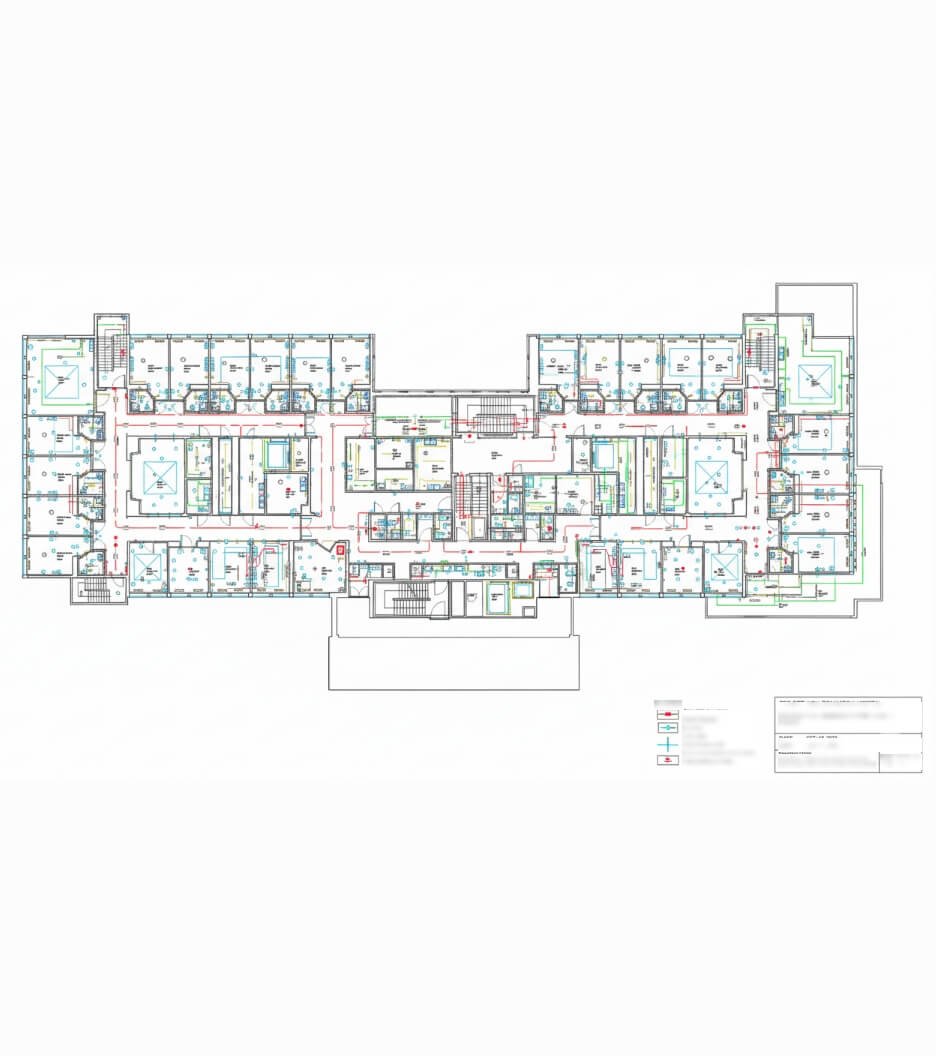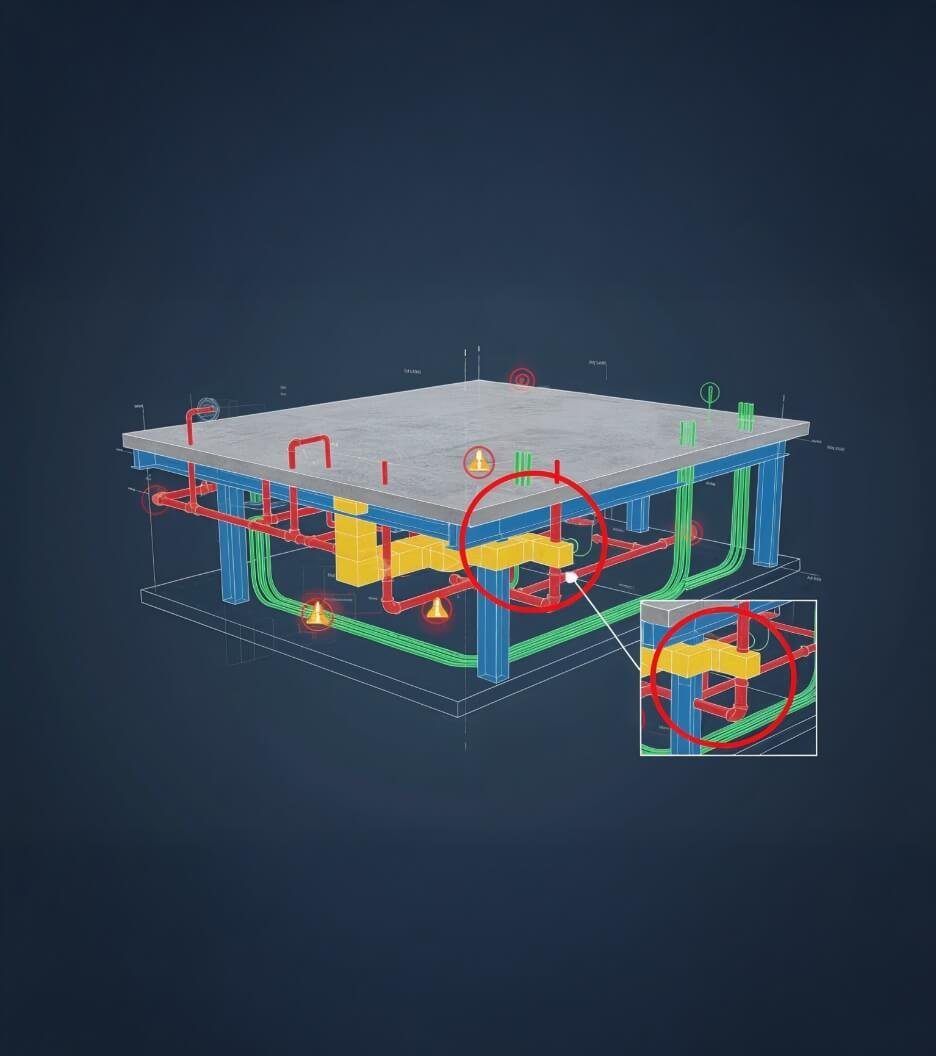 Parth Patel
Parth Patel
How Global Firms Are Leveraging MEP BIM for Competitive Advantage
 Parth Patel
Parth Patel

Send Us Your Requirement
The architecture and construction industry has witnessed a rapid evolution that has resulted in precision, efficiency, reliability, and more safety precautions. The emergence of technology and the integration of reliable resources enable architects, engineers, designers, contractors, and other professionals to enhance the overall outcome while strictly aligning with design intent without any errors.
Typically, in any construction project, regardless of size or type, errors and conflicts are common. Traditionally speaking, the architecture industry used to manually resolve mistakes that cost a fortune, significant time, and labor, leading to delays in completion and more. However, with technology and the easy adoption of approaches, AEC professionals can resolve errors without worrying about extra investment.
Thanks to the rising and most beneficial approach called building information modeling, which has transformed the working process for AEC experts and significantly improved the completion of complex construction projects. As a matter of fact, BIM brings efficiency, accuracy, and reliability, which are critical factors for modern construction landscapes. In any construction project, there are a variety of stages that require precision, keen attention to detail, and ensure efficiency in the design. Among various stages and key aspects, MEP is a significant part as it is considered the heart of the building.
MEP defines the functionality of an infrastructure, ensuring safe and liveable environments for occupants, from proper air ventilation to appropriate distribution of electricity and seamless water flow. With global BIM implementation, the MEP stage is redefined with precision, featuring keenly curated complex systems, accurate installation, and more. As a matter of fact, MEP integrated with BIM helps AEC professionals maintain harmony between all components and other architectural aspects.
The role of MEP BIM modeling services is a game-changer in the industry, enabling the synchronization of mechanical, electrical, and plumbing systems. Moreover, it has changed the entire approach for how projects are designed and executed. With the MEP BIM modeling process, AEC professionals can seamlessly plan, design, and implement the project with minimized scope of errors along with enhanced safety. To begin with, briefly explore MEP BIM and how it is a beneficial aspect for global construction firms.
Enhance Overall Building Performance with Accurate MEP BIM Services
Get a Quote
Understanding MEP BIM Services in Detail
AEC is a vast, rapidly growing, and difficult sector. Over a decade, architecture and construction firms have gained a significant position in the market. Seamlessly adapting innovations, technologies, and approaches, AEC professionals constantly look ahead for ways to enhance the current construction process. With the rising demand for sustainable solutions and the reduction of the carbon footprint as primary goals, architecture and construction are adapting to innovations. As construction projects, regardless of size, nature, and type, become more complex in design, it has become evident to maintain accuracy and efficiency at the infrastructure stage.
Architectural, structural, MEP, and more are crucial parts of the construction process and require keen attention to detail for precision. As a matter of fact, among all the stages, MEP is vital and complicated due to the need to maintain synchronization among mechanical, electrical, and plumbing aspects. Integration of BIM technology allows AEC experts to ensure precision, efficiency, and reliability. MEP BIM modeling services have become a significant part of the modern architecture and construction industry, maintaining dynamic coordination and ensuring alignment with the design.
Nonetheless, digital transformation in construction offers a transformative shift by bringing a plethora of benefits, including improved management, reduced errors and clashes, optimization, seamless execution, enhanced safety measures, and more. Traditionally, MEP was a cumbersome and time-consuming process fraught with potential errors that impacted onsite construction. With integration of MEP BIM and MEP coordination services, architects and engineers can ensure precision and efficiency while maintaining harmony in all three components. This also helps to stay aligned with the intended design and creates a streamlined workflow for every professional.
In simple terms, adopting MEP BIM modeling services involves using BIM modeling to design, coordinate, and implement MEP in a 3D BIM model. For example, integrating HVAC systems into the model requires keen attention to designing them alongside the project’s design. This requires accurate implementation of HVAC BIM services, enabling professionals to maintain precision, identify clashes early, and more. Not only this, but the adoption of MEP BIM in construction projects brings a variety of benefits. Let’s dive deeper into this.
Key Advantages of MEP BIM in Projects
In the era of modern construction, new sleek designs, efficient space utilization, sustainable practices, and more are slowly becoming key parts of architecture. Nonetheless, this helps the AEC sector reduce its carbon footprint, contribute to environmental conservation, and support green building designs and more. The significant role of MEP modeling services allows architects and designers to ensure precision, safety, and efficiency.
The traditional approach missed these qualities, which often became challenging by the end of the project. Thanks to thriving technology and innovation, the benefits of MEP BIM are endless in today’s modern era. MEP BIM services offer architectural firms reduced rework and clash detection, resulting in time and cost savings. They also provide improved interdisciplinary coordination, enhanced visualizations, streamlined communication, and more accurate cost estimation. Ultimately, these services help firms win bids by demonstrating advanced capabilities and delivering higher-quality projects. Benefits for architectural firms are:
Perks of MEP BIM for Projects
Reduced Rework & Cost Savings
Improved Collaboration
Accurate Cost Estimation
Streamlined Prefabrication
Enhanced Accuracy & Precision
Better Visualization
Increased Productivity & Efficiency
Competitive Advantage
- Reduced Rework & Cost Savings: By identifying MEP clashes early in the design process, firms avoid costly onsite modifications and rework, saving time and resources.
- Enhanced Accuracy & Precision: MEP BIM modeling creates highly accurate and detailed 3D models, minimizing design errors and inconsistencies.
- Improved Collaboration: A centralized, BIM-based model facilitates better communication and collaboration among architects, MEP engineers, and other stakeholders on a unified platform.
- Better Visualization: 3D models provide clearer, more immersive visualizations, helping firms showcase their designs and capabilities to clients more effectively.
- Accurate Cost Estimation: BIM-based tools provide precise quantity takeoffs and cost estimations, improving financial planning and helping win bids.
- Increased Productivity & Efficiency: Automation of tasks and optimized workflows through BIM tools enhances productivity and allows firms to deliver projects faster.
- Streamlined Prefabrication: Accurate BIM models can serve as fabrication-ready blueprints for MEP components, supporting off-site prefabrication and faster installation.
- Competitive Advantage: Adopting MEP BIM services allows firms to move beyond traditional methods, offering sophisticated, modern workflows and a competitive edge in the market.
Benefits of MEP BIM for Global Firms
Global firms leverage Mechanical, Electrical, and Plumbing, Building Information Modeling to gain a competitive advantage by improving coordination, increasing efficiency, and reducing costs throughout a building’s lifecycle. By creating a precise, data-rich digital representation of a project’s MEP systems, firms can make more informed decisions, streamline complex workflows, and deliver superior results.
MEP BIM Importance for Global Firms
Centralized platform
Pre-construction clash detection
Effective coordination
Energy efficiency and analysis
Digital twins for lifecycle management
Accurate cost estimation and quantity takeoffs
Improved modular and prefabricated construction
- Centralized platform: One of the significant advantages of global BIM implementation is the shared, cloud-based BIM model, which offers rich insights and details for all project stakeholders, including architects, engineers, and contractors. This centralized platform ensures that everyone works with the most accurate and up-to-date information, minimizing errors and communication gaps.
- Effective coordination: BIM adoption improves coordination and communication among professionals and enables MEP systems disciplines, architectural, and structural designs to be streamlined and accurate as per design. Additionally, BIM MEP coordination services would allow professionals to coordinate different stages of construction seamlessly. Furthermore, this prevents potential clashes or conflicts, often resulting in costly rework and delayed construction projects.
- Pre-construction clash detection: BIM software automatically identifies and resolves potential clashes between MEP systems before construction begins. Although BIM clash detection services here have become a key player for precision and efficiency. This proactive approach eliminates expensive onsite rework and minimizes delays. Any project with an error-free design streamlines the workflow without delays, resulting in success.
- Accurate cost estimation and quantity takeoffs: The data-rich BIM model allows for highly precise quantity takeoffs and cost estimations. With the help of 5D BIM, this capability improves budget planning, tracks costs in real-time, and reduces material waste. As a matter of fact, for global firms, this is one of the key perks of saving on costs, ensuring timely project delivery, and precise MEP equipment or material usage.
- Improved modular and prefabricated construction: BIM for MEP supports off-site prefabrication of MEP components or elements by providing exact dimensions and specifications according to the project for fabrication. This manufacturing process drastically reduces onsite assembly time, minimizes waste, maintains safety, and ensures higher precision.
- Energy efficiency and analysis: BIM enables engineers and professionals to conduct detailed energy analysis and simulations on HVAC and lighting systems. This allows for the design of more energy-efficient and sustainable buildings, which can lead to lower operational costs and help achieve green building certifications. Moreover, it helps to achieve sustainable design demands and save the environment.
- Digital twins for lifecycle management: Digital transformation in construction offers long-term advantages. Firms create a digital twin of the infrastructure, which is a live, dynamic replica of the physical asset. This allows facility managers to access embedded data about MEP systems, supporting ongoing maintenance and operations, also making the renovation much easier.
Real Life Projects for MEP BIM
The world is big, and the AEC industry has come a long way. From the beautiful historical monuments we see today with detailed carvings, there are modern architectural structures around the world that undoubtedly represent modern design, precision, and safety. The following are some of the real-life projects that were completed with the help of MEP BIM modeling services.
- South American hospital: A global MEP consultant used BIM to coordinate a large hospital complex, which had particular MEP requirements for LEED certification.
- Iconic skyscraper: For New York’s One World Trade Center, 3D BIM modeling was essential for coordinating complex architectural and structural designs, preventing clashes, and sequencing construction.
- Middle East airport: By using MEP BIM modeling services, a Muscat-based contracting company saved significant time, manual labour work, and $7 million on an airport project by preventing rework.
- Indian infrastructure: Major projects like the Bangalore International Airport expansion and the Nagpur and Delhi Metro Rail projects used 5D BIM for better visualization, cost estimation, and management, and also MEP coordination services for the public transport network.
These are some key examples that serve as living proof of digital transformation in the construction industry. They demonstrate how precision, safety, time, and cost savings, efficiency, and more are seamlessly achieved with the proper use of technology and expert guidance. As a matter of fact, the benefits of MEP BIM are numerous, but they require expertise, technical proficiency, and a solid understanding of the approach to achieve the desired project goals.
Outsourcing MEP BIM for Accurate Outcomes
As briefly discussed regarding MEP BIM and its key benefits, it is clear that this approach requires a streamlined workflow and software proficiency. With technological innovation and constantly developing software, it becomes challenging to keep up with the updates and implement them. Global AEC firms continually look for efficient and cost-effective approaches for MEP BIM services. Typically, any AEC firm is occupied with a plethora of tasks; outsourcing MEP BIM modeling services is a significant and beneficial concept.
Partnering with third-party service providers brings significant benefits and helps to gain desired results. The following are some of the considerable advantages of partnering with a top BIM company;
- Access to technology and experts
- Accuracy and efficiency
- Streamlined process
- On-time project delivery
The list of benefits can be extensive; however, partnering with the right firm is essential. UniquesCADD is a renowned provider of MEP BIM services, with many years of experience and a pool of talent for MEP.
Final Takeaways
Integration of MEP BIM modeling services in modern AEC projects enables the maintenance of precision and harmony among all three components. This also helps in smart prefabrication for onsite installation.


